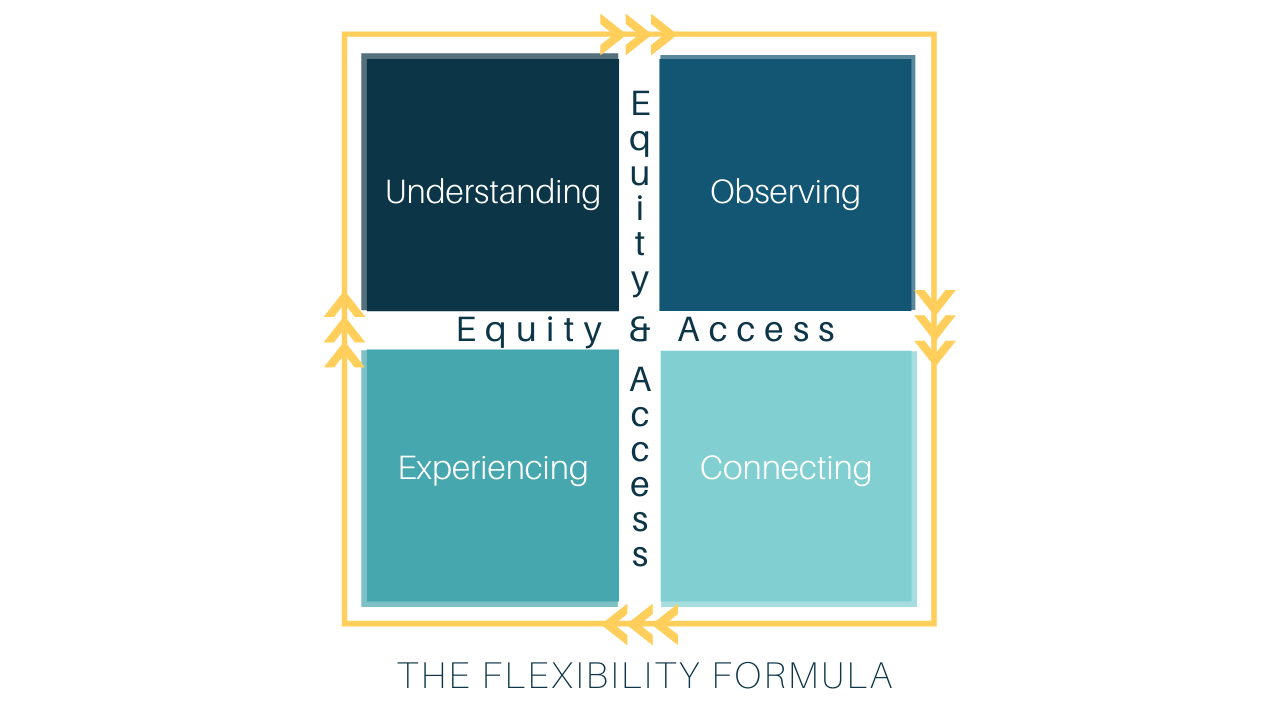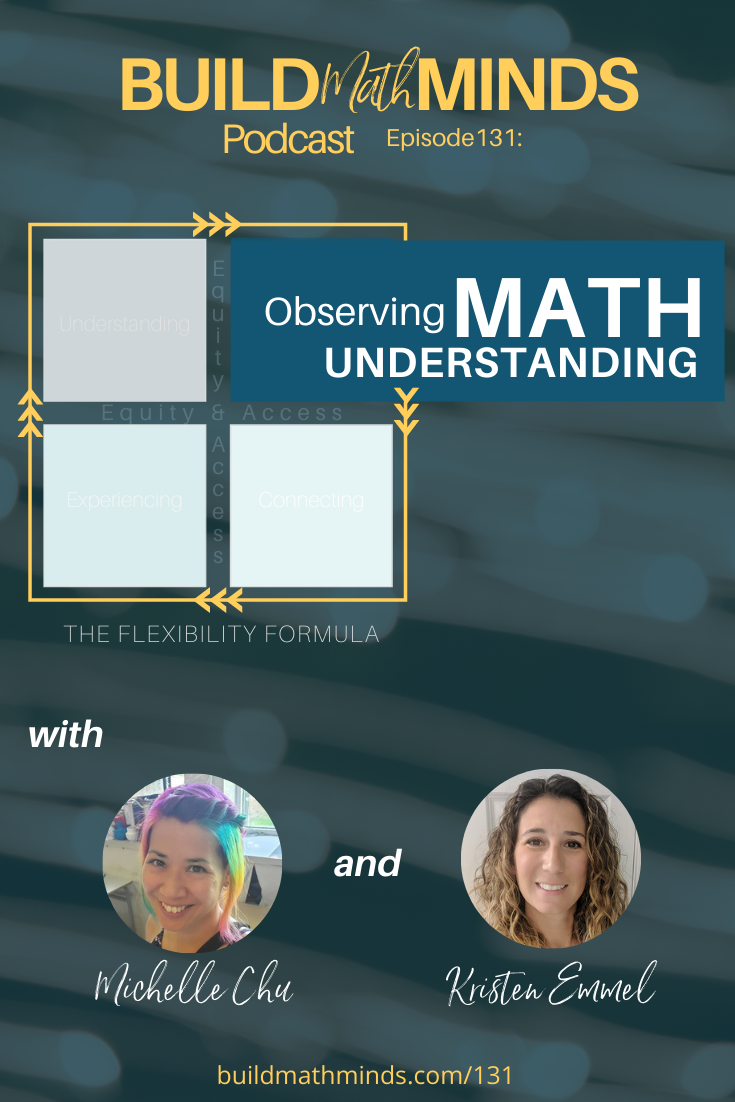Resources mentioned in this episode:
Episode #130: Building our Understanding with Dr. Ange Rogers, Duane Habecker, and Shannon McCartney
Building Thinking Classrooms by Peter Liljedahl
Welcome fellow Recovering Traditionalists to Episode 131. Today we are looking at sessions that help us with Observing Math Understanding with Michelle Chu and Kristen Emmel.
The free 2022 Virtual Math Summit is just around the corner on February 26 & 27 and all of the sessions at the summit address one or more of The Flexibility Formula pillars: Equity & Access, Understanding, Observing, Connecting, and Experiencing.

So I’m highlighting how a few sessions address each of the 5 pillars. In episode 130 we looked at the Understanding pillar. In this episode we are going to address the Observing pillar by taking a listen to a clip from Michelle Chu and Kristen Emmel’s sessions.
Observing is how we can assess kids in the way we were originally meant to. Assessing nowadays means that we give students a standardized and/or norm-referenced test that is used to report progress but often doesn’t impact our instruction. If we want a student-centered math classroom then we need to assess what our students know (and don’t know) and then use that information to inform our instruction. Assessment comes from the latin verb assidere, which means ‘to sit with.’
In an ideal world we would be able to sit with each student to assess their mathematical understandings and misunderstandings. But the reality of our education system makes that near impossible. Michelle Chu and Kristen Emmel both share ideas on how we can start to implement assessing through observing at the 2022 Virtual Math Summit.
Michelle’s session is all about her experience implementing the ideas from Building Thinking Classrooms by Peter Liljedahl and Kristen’s session is about ways to make student thinking visible by replacing math tests with math chats.
Let’s listen in on part of Michelle Chu’s session as she shares how she uses Vertical Non-Permanent Surfaces. When kids are showing their thinking on vertical non-permanent surfaces, it allows you to see their work as they are doing it. That allows you to see their understandings and misunderstandings along the way instead of just seeing their finished product that they turn in, which allows you to make instructional decisions based upon what you are observing in the moment. Here is Michelle with some tips on using Vertical Non-Permanent Surfaces to Observe your students’ mathematical thinking:
Michelle: “Another part of Toolkit 1 is vertical non-permanent surfaces. So as part of Peter’s research, he looked into different kinds of surfaces, right? Chart paper versus chalkboard versus whiteboard. And he looked at whether it made a difference if those surfaces were vertical or horizontal. And what the research showed was students got started faster and they kept working for longer if they were standing up. So they’re active and visible and they can’t hide. And if they were at a non-permanent surface, so it didn’t matter what kind of surface. Chalkboard, whiteboard, anything erasable was good. And here are some ideas for non-permanent surfaces, because not everybody will have whiteboards. So as you can see in the bottom right hand picture, I have whiteboards, but in front of them I have these portable whiteboards and those are made of shower board that have been cut up and our district did that.
And I actually layered them because it just gives me more whiteboard space in the room. And if there’s information that I don’t want to be erased, we can either put a portable whiteboard up in front or take it down if that’s the case. As you can see in the top pictures, I also have Wipebook pages and there are different forms of portable whiteboards, different brands. Wipebook is just the one I have. It’s double-sided. One of the sides has a grid, which I love. I have found that Wipebooks can rip quite easily. So a lot of people recommend you tape around the edges with tape to reinforce it. I have mine stapled to bulletin boards because I find students get really vigorous when they erase and having it stapled to the board just keeps them a little bit safer.
I have some windows in my room that we don’t actually use because in order to reach the window, you have to lean over a heat register. So all dusty air from the fan gets blown in your face. But if I were to use windows, what I found is if you tape large sheets of tissue paper or poster board on the opposite side of the window, then the contrast is so much better and you can see what students are writing and students can see which other groups are writing, which we’ll talk about later, but great for increased mobility of knowledge. So that works too with glass. I’ve heard of people using the safety dividers as surfaces. I’ve also heard of people taking clear shower curtain and wrapping it around cupboard doors, for example. Those are all examples of non permanent surfaces that students can use.
At my stations, you’ll see socks hanging and those are just… My husband bought the wrong size socks, so we had extra for my kiddo and those are erasers. Because for some reason, if students don’t have a whiteboard eraser, they use tissue paper, which is kind of a pain. So I hang socks for them to use as erasers. And they also function as marker holders because ideally you actually want one marker at each station so that the students have to work as a team, that they’re not each writing independently.”
Up next is Kristen Emmel talking about using number sense routines to assess students. In this particular clip from her session she is sharing some of the things they learned that we should watch out for as we try to use number sense routines to observe what our students understand:
Kristen: “As I said in the beginning, I love using different number sense routines in the classroom. I think that they just encourage so much flexible thinking and really get every student to hear and consider different approaches to a problem, which is so incredibly powerful. But what I discovered in trying to create these different math chats is that some tasks make for really rich conversation but might not help us actually assess a specific learning target. So for example, this one on the left, look at the two pictures. What’s the same about them? What’s different? It’s hard to see but there’s a line in the two red pieces and I was trying to use this to assess a students understanding of equivalent fractions. So this was for our new fourth graders. What did they understand from third grade?
I wanted them to see that the two halves is equal to a whole, or we have four fourths equal to the whole and what we got was talks about squares and rectangles and they look like Chiclet gum and all these different things that was the same and different but really very minimal fraction conversation. So in creating math chats, we really need to make sure that we are giving them enough information or enough of a setup to truly assess the target we’re looking for while still allowing enough space and flexibility for them to explain their thinking in their own unique way. So not every routine is going to fit perfectly for an assessment tool.
The other thing that we learned is that the younger students, especially our first and second graders really had difficulty explaining their thinking. I had mentioned that in the hundred chart task that having to add that piece of convince me that you know that the pink box has whatever the solution is.
We determined that just saying ‘solve this problem and explain your thinking,’ wasn’t sufficient because the students just didn’t have enough of an awareness to explain that process, to know how they knew. So we started adding these little prompts. So for this problem we wanted them to build the number 341 in two different ways using base 10 blocks and so basically build it in one way and then build it a different way, making a fair trade and you’ll see again, we have the microphone icon for them and asking them ‘how do you know the two models are equal to each other?’ So trying to really give them a specific question for them to respond to and really it served almost like a sentence stem. We’re going to give you a specific piece to comment on. I did still have teachers sometimes ask me, how do we get them to respond in a more articulate way?
My response was often, do more number talks in the classroom. If we want our students to really share their thinking in these math chats, they need to be comfortable sharing their thinking in the math classroom in general. So the more that we provide them the time and space in the classroom to share their thinking, to hear other options and opinions, it’s going to make it much better. It wasn’t perfected. Like I said, first and second grade were definitely a little more challenging but it’s something worth, I think, working towards because it also made us really reflect on our own teaching practices and what were we doing in the classroom to promote this type of discussion, so things that we’re learning in the process.”
Kristen and Michelle share many more ideas about how they are changing up the way they assess their students as they move to a system that involves more observing of student thinking. There are other sessions at the 2022 Virtual Math Summit that address the observing pillar as well.
I hope this helped build your math mind, so you can build the math minds of your students.
This episode is brought to you by the Build Math Minds professional development site. It’s an online site full of PD videos designed specifically for elementary teachers to help you build your math mind so you can build the math minds of your students. If you are interested in getting in-depth Math PD at Your Fingertips, become a member of Build Math Minds. Just go to buildmathminds.com/bmm and depending upon when you are listening to this, enrollment might be open or you can join the waitlist and get notified when it opens again.




